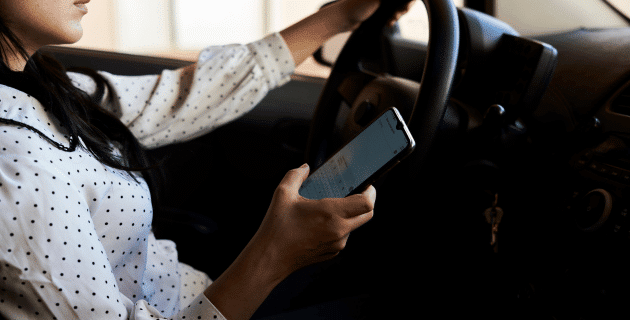We all want to think that we’re good drivers. The truth of the matter is, every once in a while, we get distracted…some of us more than others. We reach for that French fry. We have an argument with the kids in the backseat. We hear our phone ding and instinctually grab it to look at a message. We know better, but we do it anyway.
In honor of April, Distracted Driving Awareness Month, here’s a reminder about the dangers of distracted driving and why it’s important to stay focused behind the wheel.
Distracted driving by the numbers
Nine people die each day in crashes caused by distracted driving, reported the Centers for Disease Control (CDC). Over 3,100 people were killed and 424,000 injured due to distracted driving in 2019. One in five who died weren’t even in a vehicle. They were walking, riding their bikes, or simply at the wrong place at the wrong time.
Distracted driving deaths have increased by 12% from 2020 to 2021, reported the National Highway Traffic Safety Administration (NHTSA). Drivers aged 18 to 34 are more likely to die due to distracted driving than any other age group. It’s no surprise that teens, with their inexperience behind the wheel and the world at their fingertips, are at greater risk for distracted driving. A survey of U.S. high school students found that 39% admitted to texting while driving in the past 30 days.
What is distracted driving?
Distracted driving is defined as any activity that takes focus off of the road. There are three major types of distractions, as defined by the CDC:
- Manual: This causes you to take your hands off of the wheel, such as when you are reaching for something. If you’re eating while still looking at the road, that could be a manual distraction.
- Visual: This is anything that takes your eyes off the road ahead. If you are rubbernecking, fiddling with the radio, or even looking at your GPS, that could be a visual distraction.
- Cognitive: This type of distraction takes your mind off driving. If you are texting or emailing while driving, that’s a cognitive distraction. If you’re engaged in conversation, daydreaming, or worrying, that takes your attention away, too.
Reaction time and distracted driving
You may think that glancing at your phone to read a text is no big deal, and takes no time at all. Consider this. If you’re reading a text while driving 55 mph, you’ll probably take your eyes off the road for 5 seconds. According to NHTSA, that’s like driving the length of a football field with your eyes closed. Five seconds is more than enough time to whiz past a stop sign, slam into a car that suddenly brakes in front of you, or seriously hurt or kill a pedestrian. Texting while driving increase your chances of crashing by 2300%.
Even hands-free devices can be a mental distraction. An AAA study found that it takes 27 seconds to regain your full attention after engaging with your hands-free device. At 25 mph, that’s enough time to travel nearly three football fields.
How distracted driving affects your insurance
Many states have bans for handheld cell phones while driving. It is your responsibility to know the local laws, even if you’re traveling out of state. If your state has banned cell phone use, even holding your phone at a stoplight can get you a ticket. If the engine is turned on, your car is considered in motion.
Tickets for illegal cell phone use can come with hefty insurance penalties. Forbes noted that if you are found to be distracted driving, it could raise your insurance rates as much as 41% depending on the state where you live. The average is an increase of 16%. So, in addition to the damage that distracted driving can do to people and property, it can affect your wallet, too.
Tips to stay focused
Follow these tips to keep your eyes on the road, your hands on the wheel, and your mind on driving.
-
- Avoid multitasking while driving. Do everything you need before you start the car. Set up the GPS. Choose radio presets. Send any texts you need to send before you start the car.
-
- Leave your phone in a secure place. Enable the “do not disturb” setting while you’re driving. Your phone will silence texts and maybe even send an automatic response text that tells people you’ll reply to them when you’re not driving.
-
- When in doubt, pull over. Find a parking spot or lot to enter an address in a GPS or call or text someone. Plan breaks to eat, text, and talk.
-
- Lead by example. If you have teens or pre-teens, they are watching your driving habits and taking note.
-
- As a passenger, you can help the driver focus on the road. Limit distractions around them, and speak up if you see them starting to text or otherwise shift their attention.
-
- Educate yourself and your loved ones on the dangers of distracted driving.
Safe travels.
This article is furnished by California Casualty, providing auto and home insurance to educators, law enforcement officers, firefighters, and nurses. Get a quote at 1.866.704.8614 or www.calcas.com.
- Graduation – When to Remove Your Child from Your Auto Policy - May 18, 2023
- How to Prevent Catalytic Converter Theft - May 17, 2023
- How Much Does Home Insurance Cost? - May 17, 2023

